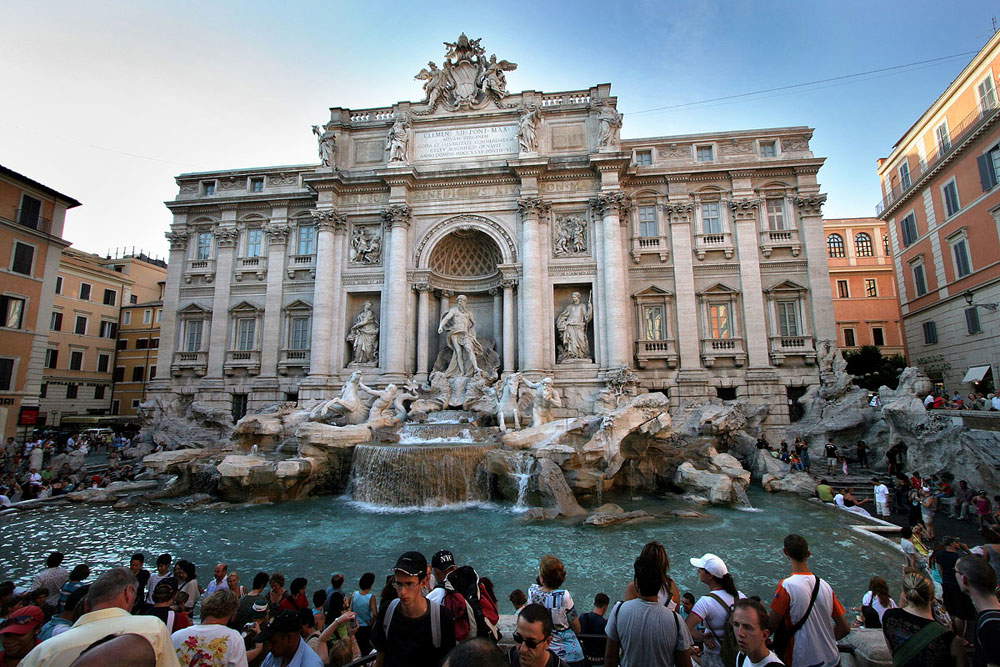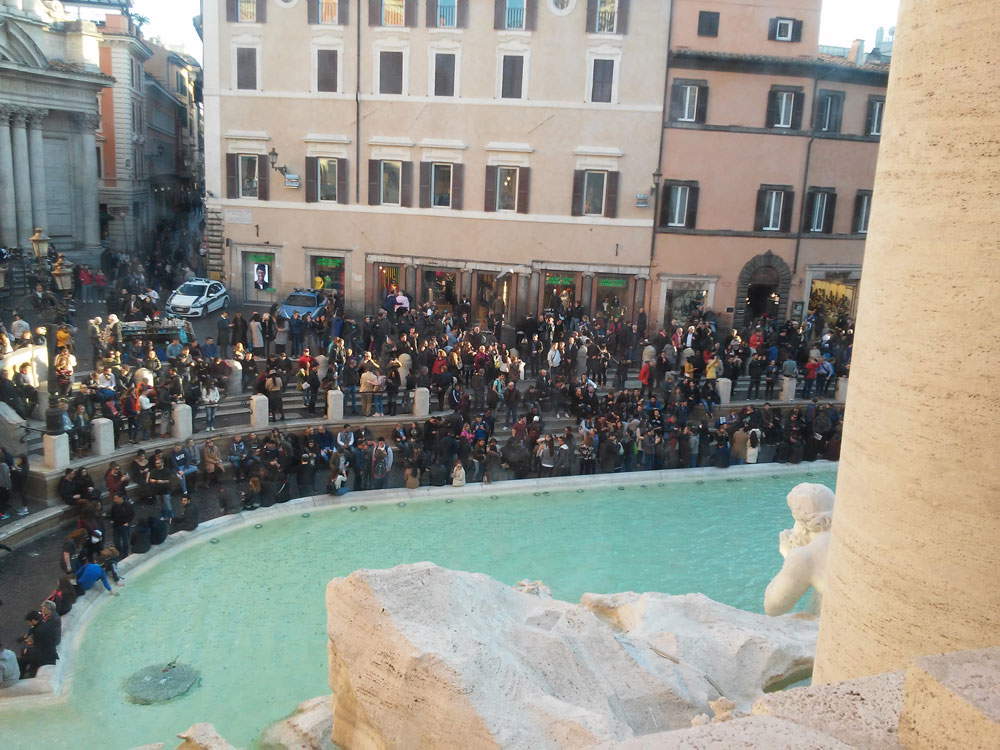Virginia Raggi, mayor of Rome, must have recently been on a visit to the Tower of London: there, the visitor who wants to look at the Crown Jewels is forced to pass on a treadmill that prevents stopping in front of the precious collection. Or, more prosaically, he must have taken the highway before going to the Porta a Porta studio from where, a few days ago, he declared that in the City Hall they are thinking, to solve the crowding problems at the Trevi Fountain, of a “fruition path for which there is no possibility of stopping.” I am reporting the sentence exactly as it was uttered by Virgina Raggi, in order to avoid improperly attributing to her any ideas about walkways, treadmills, obligatory paths or whatever else, since for now the quotation mark mentioned above is the only statement we have on the subject. In other words, there is an idea hovering, but we do not yet know how the mayor intends to put it into action: however, it is enough to know that, whatever the form, citizens and tourists who want to visit the Trevi Fountain will be prevented from stopping in front of the monument. In perfect “highway toll booth” style, in short: you arrive, pass through without stopping, and leave again.
 |
| The Trevi Fountain. Credit |
Frankly, it is hard to imagine a worse measure than this to curb the degradation that mass tourism brings with it and that, on certain days, seems not to spare even the scenic monument designed in the 18th century by Niccolò Salvi. In the meantime, this would be a very short-sighted solution: and it is worth pointing out how, in the context of such an inability to consider cultural heritage from a broad perspective, the 5 Star Movement ’s mayor enjoys the company of politicians belonging to almost the entire current constitutional arc and unaccustomed to thinking thoughtfully about the problems that plague cultural heritage. And this time, too, we are faced with an ill-considered solution: a “path without a chance to stop” would not be a solving measure, because all it would do is dilute the problem without, however, affecting its roots. Indeed, no one forbids imagining even worse scenarios than the current one: in the event that the “no stopping” route is given a defined perimeter (for that matter, no other serious way to discourage passerby parking comes to mind), queues could be created at the entrance, with the obvious consequence that the much-feared degradation would run the risk of being moved from the Fountain to the surrounding areas.
But if the problem were only of a practical nature, there would almost be something to be content with. Has no one at the Municipality of Rome thought about how mortifying an imposition might be that, without any necessity dictated by reasons of conservation, forces a citizen or a tourist not to be able to contemplate a work of art that is surely worth more than a hasty glance? It is evident that such a measure is the child of a mentality that considers the monuments of one’s own city solely as attractions for tourists, who perhaps stay as little as possible: the comparison may appear trivial, but Virginia Raggi’s stunt resembles more the famous “finished rice cake” sketch than an idea of a good administrator. Not to mention the fact that the Trevi Fountain is inserted in a square that is part of the historic center of Italy’s capital city, thus of its oldest heart, of an urban fabric that has been formed over the centuries and that, consequently, is an integral part of the identity of its citizens. A square on which, moreover, there still insist activities run by Roman citizens, on which overlook institutions of primary importance (the Central Institute for Graphics, for example), and which is crossed, yes, by tourists, but also by natives who go to school, to work, to the library, to the café, to shop. How should a citizen feel when he suddenly sees his square turned into a playground attraction? Our historic centers are not amusement parks: yet it seems that politicians of all backgrounds and colors agree on that assumption, at least in deeds or ideas.
 |
| A view of Piazza di Trevi from one of the windows of the Central Institute for Graphic Design. |
It is worth remembering that if the historic center of a city is considered only by virtue of its potential attractiveness to tourists, the administration is defeated regardless. We will never tire of saying that culture is a form of investment, in the highest sense of the word, because it is an investment in our future: through culture we form conscious and respectful citizens, and who perhaps are able to feel the monuments as their own and are strongly sensitive to the heritage. The real problem (if you can call it that) is that investing in culture and educating about heritage are actions that require planning, breadth of vision and considerable skills, and whose results are seen in the long term. In recent times, unfortunately, there has been a very bad custom: the desire to evaluate the work of a local administrator at close quar ters. With the result that the administrator, in order to avoid losing consensus and votes, is often forced into draconian measures, which may perhaps work in the short term, but often do not solve problems. It seems that even Virgina Raggi, pressed by a public opinion and certain press that always place her in the eye of the storm, with her “tollbooth” model for the Trevi Fountain has succumbed to such logic. Of course: it will be said that planning heritage education takes time and that the degradation of the Trevi Fountain also needs measures that can arrest it or, at least, limit it. But has the degradation become more pronounced in recent times? Divers, swimmers, bathers, red-liquid spreaders and assorted exhibitionists certainly do not belong to a category of characters born in recent weeks. And in any case, if we really have to talk about immediate solutions (although it does not seem that the problem has all that much urgency), wouldn’t it make more sense to work seriously to provide the image of a decent city, since it is well known that decorum calls for decorum, or to equip the square with signage that seeks to dissuade passersby from disrespectful behavior, or, in the absence of better ideas, to go fishing for the most basic measure, namely making controls more efficient?
Of course: gone are the days of Giulio Carlo Argan, who, when he was mayor of Rome, took steps to advocate the purchase by the Ministry (which then actually happened) of Palazzo Poli, the building on which the Trevi Fountain rests and which is now the headquarters of the Central Institute for Graphics. And it is equally obvious that the sensitivity that an art historian may have may not even be the prerogative of everyone. Therefore, we are not asking for who knows what restoration and revitalization actions: we are only asking for a minimum of common sense. And perhaps we take this opportunity to ask Virgina Raggi to rethink her idea for the Trevi Fountain.
Warning: the translation into English of the original Italian article was created using automatic tools. We undertake to review all articles, but we do not guarantee the total absence of inaccuracies in the translation due to the program. You can find the original by clicking on the ITA button. If you find any mistake,please contact us.